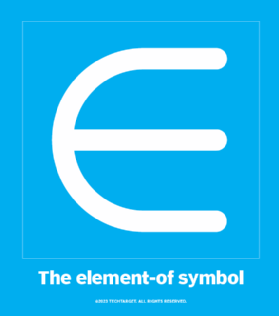element-of symbol
What is element-of symbol?
The element-of symbol is used in mathematical set theory to indicate that a point, object or number belongs to a certain set. The symbol resembles the lowercase Greek letter epsilon, but stretched out (∈). The symbol is read as "is an element of," "is a member of," "is in" or "belongs to." The symbol is sometimes referred to as the "member of" symbol or "belongs to" symbol.

In mathematics, a set is a collection of objects. The objects might be numbers, letters, variables, symbols, points on a line or other types of objects. Each object that belongs to a set is known as an element or member of that set. For example, a set named A might contain the first five positive integers: 1, 2, 3, 4 and 5. These numbers are the set's elements. Another set, B, might contain the last five lowercase letters in the English alphabet: v, w, x, y and z. In this case, the letters are the elements in set B.
A set such as A is commonly written as follows:
A = {1, 2, 3, 4, 5}
The set members are enclosed in curly braces and separated with commas, all of which are preceded by the A and equal sign. This format works the same way for set B:
B = {v, w, x, y, z}
For either set, the element-of symbol can be used to indicate that an object belongs to that set. For instance, the following expression shows how 3 is related to set A:
3 ∈ A
The expression can be read as "3 is an element of set A," "3 is a member of set A," "3 is in set A" or "3 belongs to set A." We can use the same approach to show how w is related to set B:
w ∈ B
In this case, the expression can be read as "w is an element of set B," "w is a member of set B," "w is in set B" or "w belongs to set B."
When an object does not belong to a set, we can use the not-element-of symbol in much the same way as the element-of symbol. The not-element-of symbol looks like the element-of symbol except that a forward slash runs through it (∉). The not-element-of symbol is read as "is not an element of," "is not a member of," "is not in" or "does not belong to." For example, the following expression indicates that 7 is not an element of set A:
7 ∉ A
The expression can also be read as "7 is not a member of set A," "7 is not in set A" or "7 does not belong to set A." Because 7 is not one of the first five positive integers, it is clearly not part of the set.
Learn about binary and hexadecimal numbering.
